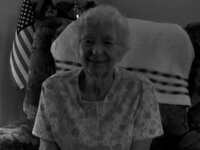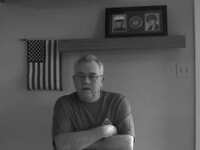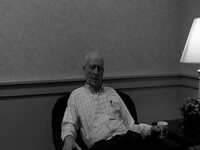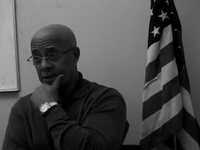Search
113 items
-
Fred played instruments early in life, especially in school. He attended McKenzie High School, where he won a scholarship to the Detroit Institute of Technology. One of Fred's first jobs was playing in nightclubs. Early in World War II, Fred worked for Ford Motor Company and was not allowed to enlist because he was a required worker. Then, in August 1942, Fred was drafted and went to Ft. Custer for basic training. He was classified as a musician and posted with the 523rd Air Force Band, which was also known as the 23rd Army Air Force Band. The band was stationed at Camp Shanks, New York, and was on duty to play for the men boarding troop transport ships, bound for Europe and Africa. When his band was shipped out, no one was there to play for them. The ship that Fred was on went first to La Havre, to drop off infantry troops. The band disembarked with them, and then found out they were supposed to go to England. They had to re-board and continue on to Southampton. He spent most of the war playing at hospitals and dances, but very rarely played for big name entertainers. They generally brought their own bands. During his time in England, Fred had the opportunity to travel the country. He discussed the devastation of London and surrounding countryside, the shortages of everything, and the courage of the British people. He was based in Manchester at the Base Air Dept #2, which was an arming stop for incoming planes flown by WACs. He was on base the day of the Freckelton RAF accident, when an RAF pilot lost control of his plane, and it crashed on the base. Fred talked about an unspoken privilege system, which regular soldiers felt that the band members had. Fred's wife, Helen, was his high school sweetheart. She, along with his parents and siblings, wrote to him often. He remembers having to reply to letters by writing in the latrine, for light and quiet. Fred played the saxophone, trumpet, clarinet and flute. He came home from the war in 1945, and married Helen. Fred took a job teaching music at Dearborn's Salina Jr. High School, starting in 1950-51. He continued to teach there for 32 more years. Fred lost touch with most of his war-time friends but keeps a significant scrapbook of photos taken by others and him.
-
Helen is the wife of veteran John Fidler. She was born on February 9, 1921. While her husband was serving in the Air Force, she and her sister got jobs working on the B-24s, at the Willow Run Bomber Plant. They became riveters, attaching the gas tanks to the insides of the wings. One riveter would put in the rivet with a metal gun, and a riveter on the other side flattened it with a bucking bar. Once, one of the rivets put a hole in Helen’s thumb. They were paid in cash, with many two-dollar bills. Nevertheless, she wanted to work for her country and really enjoyed it. Later, in Norfolk, Virginia, she worked at a PX, and had two German prisoners of war working for her. She said that they worked really hard and were glad to be in the U.S., instead of a POW camp.
-
John Fidler was born in Jay County, Indiana, in 1921. In October 1942, since he was mechanically inclined, he enlisted in the Air Force, so that he could work on airplanes. During World War II, the Air Force sent him to aircraft mechanic school in Lincoln, Nebraska. After six months of training, John was sent to Norfolk, Virginia, where pilots were learning to fly and fight with P-47s. He was made crew chief and became completely responsible for maintenance on one of the P-47s, and airplane he was intimately familiar with, and learned to love. During that time, the training outfit only lost two pilots. He was honorably discharged in 1946, having achieved the rank of Staff Sergeant. Fidler flew on the Pride and Honor Flight in 2009.
-
Ellis Freatman grew up in Plymouth and Ypsilanti, Michigan. He graduated from Ypsilanti High School, and was drafted into the Army, entering the service with his longtime friend L.D. Harman. They separated when L.D. went to the Air Force, and Ellis to the Army. Ellis took his basic training in Maxey, Texas, where he was selected for O.C.S. He received high grades and became a 2nd Lt. at the age of 20. Ellis's assignments included posts in different training units. He was sent to Okinawa and was often used as a replacement officer. Ellis led a platoon, but because of his age and lack of experience, he relied a great deal on his sergeant. Although the island was not fully secured, Ellis did not receive any injuries. He was discharged after serving for over three years, and returned to Ypsilanti, Michigan. Upon receiving his discharge, Ellis entered Eastern Michigan University, where he met his wife, and after receiving his degree, he was accepted to the University of Michigan Law School. After 20 years of a highly successful practice, Ellis retired. His one son is also a successful lawyer.
-
Robert Gould was born in Detroit, Michigan on November 13, 1942. His father was of Polish descent and worked as a share-cropper in upstate New York. Bob's mother was of Ukrainian descent. The farm owner was named Gould, so Bob and his brother became known as the Gould boys. His father changed the family name to Gould. Two weeks after finishing high school, Bob joined the Army, as did one of his friends. At the time, enlistees could join for two years, but draftees had to serve for three. After basic training, Bob was assigned to the First Infantry Division. When given the opportunity, he volunteered for the 101st Airborne Division. His 1st Infantry group was sent to Germany, and Bob was transferred to Fort Benning, Georgia for jump training. He qualified for jump status and was assigned as one of the Medics, which served in the clinics and hospitals. All 101st Division personnel were required to maintain their "Jump Status," which meant that they had to jump periodically. When Bob was discharged, he returned to Detroit, and went to school for six years on the GI Bill.
-
James Green was drafted in October 1943. He applied for pilot training but was turned down and was assigned to a B-29 crew, in the 505 Bomber Group, at Tinian Airfield. Tinian is one of the three principal islands of the Commonwealth of the Northern Marianas Islands, and is about 5 miles (8km) southwest of its sister island, Saipan. During a mission, when James was a replacement gunner, he was shot down over Tokyo. He did not know the names of the other crew members, and this irritated his captors when he was being interrogated. The prisoners were badly mistreated by the Japanese soldiers during their imprisonment. However, James feels that this made him a stronger person, and he has no animosity toward the Japanese people. After the war, James attended Western Michigan University, and earned a B.A. Degree. Later, he was awarded a master's degree from Central Michigan University. In 2005, when he was being interviewed, he indicated that he has 6 children, all boys He also has 13 grandchildren, and his wife was still teaching.
-
Dave Hammond served in the United States Marine Corps during the Vietnam War.
-
Donald Hanson enlisted in the Navy in 1942. He was commissioned as an Ensign in November 1943. He spent WWII as a training officer. His training tasks included Flight Instruction, Jet Training, Gunnery Training, Photo Training, and Nuclear Weapons Employment. After the war, Donald completed his studies at the University of Minnesota. Most of his time in active duty was spent in Korea with the F9F Panther Jet. Hanson flew a total of 70 missions, 51 combat and 19 noncombat. After one of his missions, he landed his plane on an Aircraft Carrier and found over 300 holes in the plane from enemy fire. Hanson got his nickname because he liked flying low. During one training flight, he and two trainees flew under telephone wires. Although he was reprimanded, he felt he got off easy. From that time on, the other flyers called him "Hoppy." Hoppy retired in 1964 as a Navy Commander. He and his wife now live in Novi, Michigan, at Fox Run Residents. Both he and his wife have been very active in a variety of volunteer activities.
-
Mr. Harwell enlisted in the United States Marine Corps in 1942, as he was confident he would be drafted regardless. Initially serving as a military journalist in Washington, D.C., he was sent to the Pacific Theater to report on the Japanese surrender. In 1945, he also traveled to China to report on Japanese war crime allegations in that country. After returning to the United States and his discharge from the Marine Corps, Harwell would go on to broadcast games for the Detroit Tigers for over forty years. Known as the "Voice of the Tigers" Harwell is still honored today by the Detroit Tigers at Comerica Park in Detroit.
-
Phillip Hayner was born in Ypsilanti, Michigan. He joined the Navy directly after Pearl Harbor. Although he was mildly colorblind, Phillip was assigned to the Signal Corps. Somehow, he missed the eye exam at Boot Camp. After Boot Camp at Great Lakes Naval Station, he was assigned to the Signal Corps, and briefly to Navy Choir Company 385. From the Great Lakes, he was transferred to Norfolk, where he was assigned to the Aquitania, which eventually landed in Glasgow, Scotland. On the third wave at Normandy, Phillip was aboard the LCVP, which carried 15 men. His unit was responsible for setting up a Command Post. Most of the action was north of his position. There were times when the German planes unloaded their leftover bombs on his unit. After more than three months on Normandy, his unit returned to England and was assigned to the Empress of Australia, which carried 2,000 German POWs to New York. From there, Phillip’s unit was sent to Camp Pendleton, California where they trained in landing their craft. Afterwards, they were sent to Hawaii, and then on to Okinawa. On Okinawa, their unit was responsible for taking fresh troops to the island, and returning troops to the Philippines, for R & R. Phillip married while he was on leave. Upon his discharge, he and his wife returned to Michigan. They had three children, all of whom did well in their chosen fields. Phillip is a retired tool and die maker, and now lives in Manchester, Michigan.
-
Lester Heddle was born in Milford, Michigan, on February 23, 1918. After completing high school, he was drafted on March 26, 1942. Following training in Texas, he was sent to the South Pacific. Lester spent much of his time in New Guinea, and then Mindoro in the Philippines. He was part of the 58th Air Service Group. Lester did some boxing while he was in the Service. Although he did not receive any wounds, his unit was subjected to Kamikaze attacks. Lester was discharged shortly after the Japanese surrender. He returned home to Michigan, where he received his teaching degree. Lester attended Eastern Michigan University with his wife. Since they had two small children, Lester took classes in the afternoon, and his wife took morning classes. Lester taught 6th grade in area schools.
-
While attending Eastern Michigan University, Mr. Henderson completed his basic training requirements and upon graduation was commissioned in the United States Marine Corps as a 2nd Lieutenant. Mr. Henderson would then go on to serve for several years in Vietnam. After his discharge from the Marine Corps, Mr. Henderson worked as both a pilot for General Motors and was transferred to the United States Air Force Reserve stationed at Selfridge Air National Guard Base in Macomb County, Michigan. Upon his retirement from the Air Force Reserve, Mr. Henderson had been awarded the rank of Major General.




